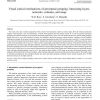Free Online Productivity Tools
i2Speak
i2Symbol
i2OCR
iTex2Img
iWeb2Print
iWeb2Shot
i2Type
iPdf2Split
iPdf2Merge
i2Bopomofo
i2Arabic
i2Style
i2Image
i2PDF
iLatex2Rtf
Sci2ools
NN
2000
Springer
2000
Springer
Visual cortical mechanisms of perceptual grouping: interacting layers, networks, columns, and maps
The visual cortex has a laminar organization whose circuits form functional columns in cortical maps. How this laminar architecture supports visual percepts is not well understood. A neural model proposes how the laminar circuits of V1 and V2 generate perceptual groupings that maintain sensitivity to the contrasts and spatial organization of scenic cues. The model can decisively choose which groupings cohere and survive, even while balanced excitatory and inhibitory interactions preserve contrast-sensitive measures of local boundary
| Added | 19 Dec 2010 |
| Updated | 19 Dec 2010 |
| Type | Journal |
| Year | 2000 |
| Where | NN |
| Authors | William D. Ross, Stephen Grossberg, Ennio Mingolla |
Comments (0)

